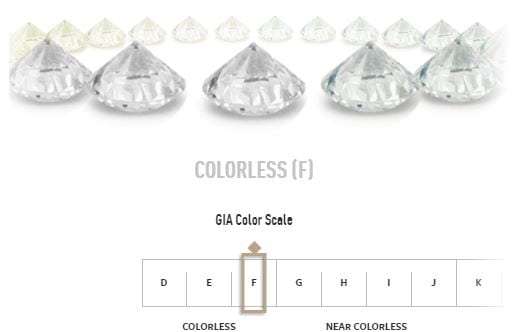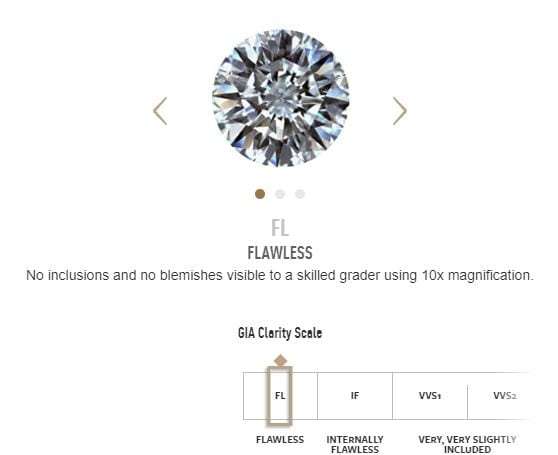Navigation:
→ Selecting the Perfect Stone
→ Selecting the Perfect Gemstone
→ How We Select Our Diamonds
→ Using Your Own Stones
→ Using Your Own Metal
How To Choose Your Perfect Diamond
Choosing the perfect diamond can be somewhat of a daunting task and something that shouldn’t be rushed into. Unfortunately, even if you have done some research into the ‘The Four C’s’ there is so much conflicting information available that you may come away feeling more lost than when you started. Hopefully the following information we have collated for you, will stand you in good stead to choosing your forever stone.
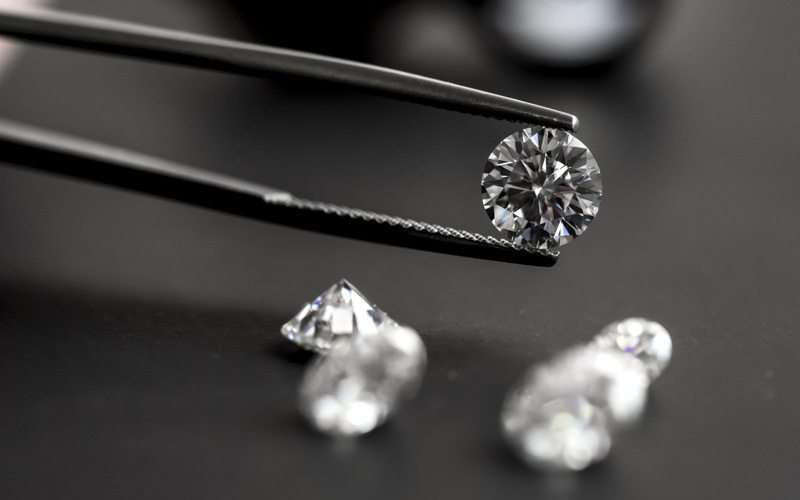
Choosing Your Criteria
The information given by jewellery professionals can alter significantly depending on who you speak to. High Street jewellers selling stock and carrying loose diamonds will have one primary concern and objective; to shift the stock they have. This is not to necessarily these diamonds will be of a lesser quality without certification, but the specifications of diamonds are so vast it’s hard to know what you are really buying.
We would recommend doing your own research and consider what the most important factor for you is when purchasing a diamond before going any further.
What is it the most important aspect to your diamond decision? Is it a case that size is the most important factor or is it the colour of the diamond? There are many contributing factors to consider in order to choose a diamond you are going to be happy with for a lifetime, that the largest aspect of choosing your perfect diamond is narrowing your criteria down.
The Four C’s
The majority of information surrounding diamonds is based on ‘The Four C’s. These consist of; Carat, Colour, Clarity and Cut.
Cut
Cut is often confused with the shape of the diamond, but these are two different things.
The shape of a diamond is just that, it is either round, oval, heart, marquise, and so the list continues. Cut is a combination of polish, symmetry and cut, which all contribute to the overall cut grade. Without the correct combination of proportions and angles, diamond can appear dull and lifeless.
There are two main families of cut; the ‘brilliant’ cut which means that the facets are variations of triangular and kite shaped which radiate from the centre and arranged in a way that optimises fire and sparkle. A popular example of this is the traditional round brilliant cut. Then there is ‘step’ cut which means the facets are rectangular and arranged in parallel lines to the girdle on the crown and pavilion. The emerald cut is the most popular type of step cut. To learn more about cut click read more below
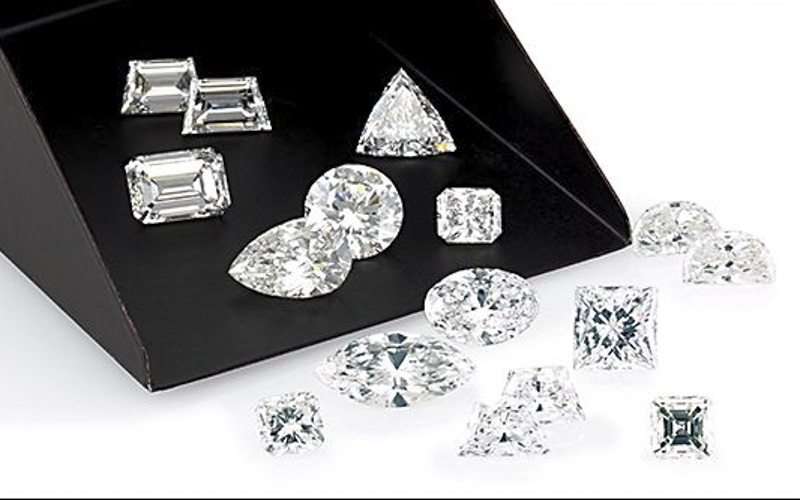
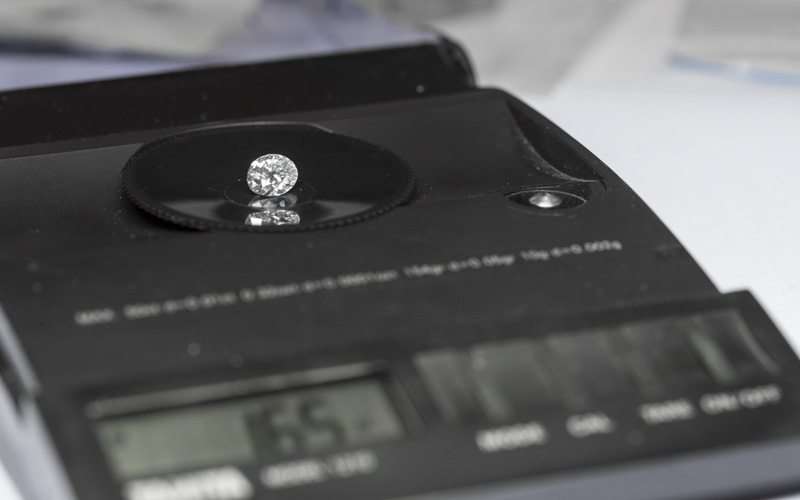
Carat
Carat is often confused with size but this is how much the diamond weighs. A metric carat is defined as 200 milligrams. You will also hear the term ‘points’ being used when referring to carat weight. Each carat is divided into 100 points which measures the stone to the hundredth decimal place. A 0.25 carat diamond can be referred to as a quarter of a carat, 25 points or a 25 pointer. As a diamond increases in size, the price also increases as it becomes more desirable, however it is a combination of all 4 cs that contribute to the price. To learn more about carat click read more below
Colour
When looking to purchase a diamond there is a lot of emphasis on the colour. The colour is graded by a diamond grading house using a master set of stones which it is compared against. The colour grading system starts at ‘D’ and goes down the alphabet. ‘D’ is classed as ‘colourless’ so it has no hue’s of yellow or brown, they are completely white. The difference between these colours is marginal, even to the trained eye. If you are Comparing a D colour to an H then it will be a more significant difference.
Another detail that is commonly overlooked when buying a diamond is the metal that it will be housed in. Some may believe a lower colour diamond will work better in a yellow gold mount so the contrast between the metal and the diamond is less. The diamond can also pick up the warmer reflections of the metal. To learn more about colour click read more below
Clarity
The clarity of a diamond refers to the natural inclusions within the stones which most diamonds have due to the extreme heat and pressure the diamonds indure whilst they are formed in the earth. These are the birthmarks of each individual diamond more commonly known as inclusions. If these inclusions are on the surface of a stone they are known as blemishes. The more obvious inclusions a stone has the less valuable it is and the more the brilliance of the diamond will be affected as these flaws interfere with light the diamond reflects.
When a trained diamond cutter is crafting the stone he makes every effort to make sure that the inclusions are not visible through the table of the finished stone. Ideally, the inclusion should be towards the outside of the stone or closer to the girdle so that they are harder to see. To learn more about clarity click read more below
→ Return to Top
Once reserved for status and royalty, the pleasure and exclusivity of owning a precious gemstone now belongs to you
Found in every colour imaginable, Gemstones have been a part of our culture for centuries. There are many ways of incorporating a gemstone into your ring whether you want it to be the centre of attention or to accentuate another central stone. Current variations on this trend include smaller (melee) gems used on the shoulders of your design or small gems used as a frame such as the ‘halo’ design which will make your centre stone pop.
Gemstones can be used to commemorate special events and milestones such as wedding anniversaries and birthstones for each month of the year.

How Do I Decide On The Perfect Stone?
We at Durham Rose advise that when you’re choosing a gemstone for your dream ring, that you ask yourself these key questions;
- Which gemstone would suit me best?
- Which Gemstones are the most durable?
- How much do gemstones cost?
Consider your wardrobe, your lifestyle, your personal taste, and your budget. All these factors are hugely important, but often overlooked when deciding on your perfect stone.
Gemstones are typically described in two major ways: “precious” and “semi-precious.” The precious gems include rubies, sapphires, and emeralds. The semi-precious gem category however is a huge parameter and can be simplified as ‘everything else’. There can be a huge price differentiation in the cost of precious and semi-precious gems. Some are very rare and command higher price tags whilst others, however beautiful, are more readily available and easily affordable.
Depending on how you wear your jewellery there are a number of ways to determine which gemstone is right for you. When you are wearing your ring it will come into contact with a variety of surfaces, some of which can damage the gemstone.
The ‘Moh’s Scale of Hardness’ was developed by German Scientist named Friedrich Mohs in 1812 to categorise minerals. The harder a mineral is, the better it will hold up against daily wear and tear and its longevity will significantly outlast that of a softer gemstone.
We at Durham Rose, would normally advise to choose a stone on the scale of around 7 or higher so that it lessens the resistance of scratching and breakage. If you are considerably practical with your jewellery on, we would normally recommend the higher up on the scale the better.
Why Do The Prices Fluctuate So Much?
There are a few factors which can dramatically influence the way in which a gemstone is priced. This includes the following;
Gem Colour
A gemstone’s colour is described by its natural tone and hue. For many the colour is the most important factor when choosing a gemstone. For most stone types, an intense, heavily saturated colour of medium tone is attributed the highest value. Many gems are enhanced to improve coloration and strength. We guarantee that we only source stones which have been treated in accordance to industry standards.
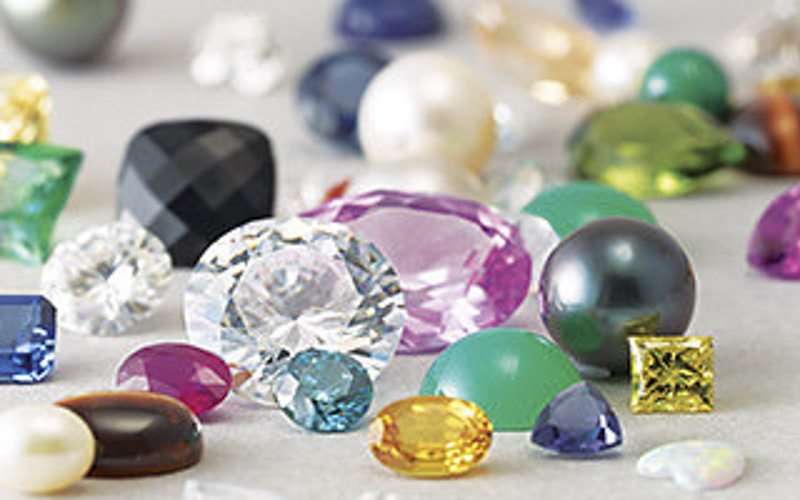
Gem Cut
For the majority of gemstones, an ‘excellent cut’ is rated by the stone’s ability to reflect light, its symmetrical appearance, and the lustre of its polish. A five-tier rating system—excellent, very good, good, fair, or poor—is used to measure the quality of a stone’s cut. Most gemstones are much deeper if you are comparing it against a diamond. Gemstones need to be cut deeper to help bring out their beautiful vivid colours. If a gemstone was to be cut in the same manner as a Diamond, chances are it would appear light in colour and in some cases they can even look transparent! In summary, your gemstone will then lack those intense dramatic hues that gemstones are renown for.
Gem Clarity
Precious gemstones have some degree of naturally occurring inclusions which can be in the form of a cloud, or crystal. These inclusions can be more prominent in certain stones. Some may argue that it provides the stone with uniqueness and personality.
High quality gemstones are relatively clear to the naked eye. Gemstones that are entirely clear and contain no inclusions are most likely man made.
Gem Size
A gemstone’s size is described by its millimetre measurements rather than its weight, as different stone compositions can vary in density. Gemstones with larger measurements are generally valued higher than those with smaller measurements. When it comes to shopping for gemstones, forget the ‘Carat Sizes’, and instead look at the millimetre sizes and the intensity of the colour instead.
→ Return to Top
Whether this is your first diamond purchase or you have set specification’s in mind we will guide you to make sure you find the perfect stone.
Each diamond that we hand select has been graded independently by the leading labs in the world, the American Gem Society (AGS) or the Gemological Institute of America (GIA). This is because they hold strict regulations and ensure each diamond meets the highest level of quality.
How much should you spend on your perfect diamond?
The answer is whatever you feel comfortable with. Our advice is to pick a price point in which you feel comfortable with and we can best advise you on how to maximise your budget to its full potential and select a stone which you will love over a lifetime.
Some of our clients prefer to go for a diamond with a high colour grade or a high clarity grade and are willing to compromise on size, others, on the other hand, want something slightly more substantial and concerns lie with the carat weight even if the remaining parameters of the diamond are less ideal.
The one thing that we would ask you to prioritise however is the cut quality of the diamond.

Cut, not the place to cut corners…
Cut refers to the proportions of the stone graded by the independent bodies: American Gem Society (AGS) or the Gemological Institute of America (GIA)
A well-cut diamond will not only enhance the brilliance which is the white light but also the fire which is the rainbow colour light and the scintillation which is the pattern of light and dark areas and ultimately the sparkle of the diamond.
A well-cut diamond can help diminish the impact of inclusions and make even yellower stones look whiter. Even if the stone is in the top parameters of the grading chart, without the ideal proportions the stone would be lifeless.
One of the most important things for us is that the diamond has been cut to reach its maximum potential and that the light return is the best that it can be. This way we can ensure that whatever your budget and the parameters you prioritise you have something which will light up the room and will be cherished forever.

→ Return to Top
Something Old, Something New…
What Does Remodelling Mean?
If you have an item of jewellery which has been inherited from a loved one or a design which is in need of a new lease of life then our remodelling service is the perfect solution to re- invent something perfect from something tired and unloved.
We can reuse existing metals and stones or even just transfer a key design element. The result would be a beautiful more polished item of jewellery which still holds sentiment and can be cherished for many more generations to come.
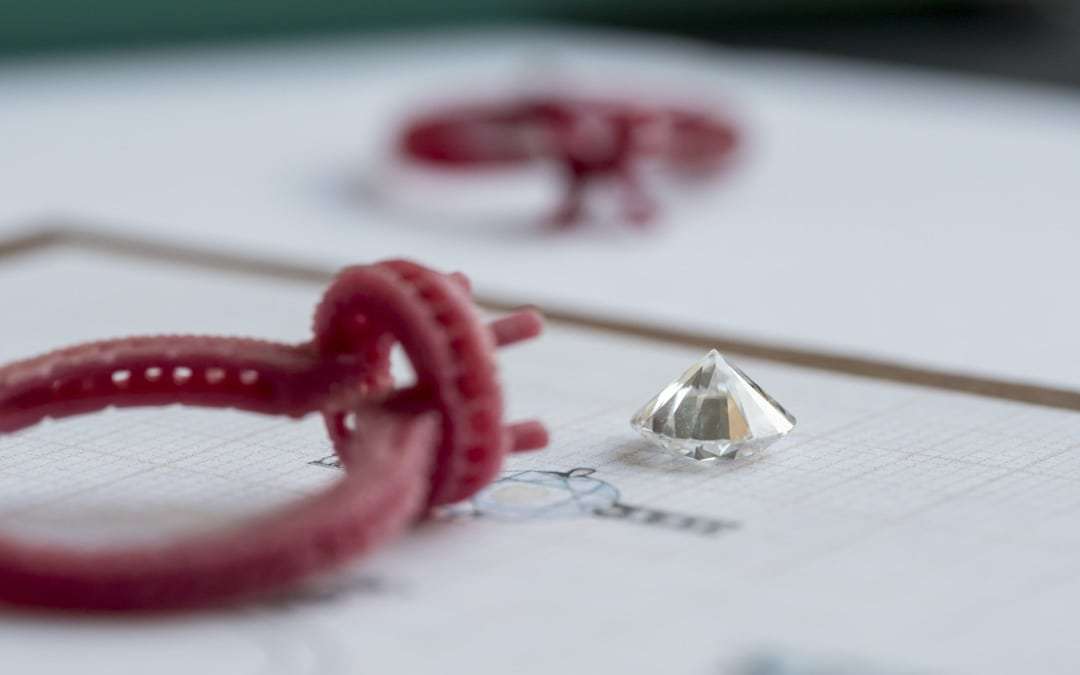
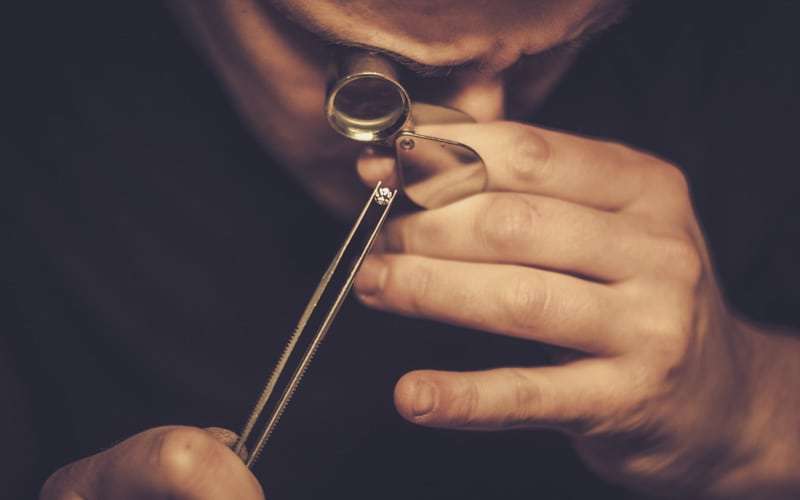
Reusing Gemstones
The reusing of stones from preexisting designs is a great way to add a sentimental touch to a new ring and also an ethical approach as we are potentially recycling materials. When using stones however, you have to take into consideration the type of stone and the condition it is in. Metal from the existing setting could be obscuring chipped or damaged stones.
When we receive stones we assess them and can advise you on the best way to show them off in a new setting. If you are looking to reset softer gemstones, such as an emerald, although great care and attention is given they can be more susceptible to damage.
It is also important to keep in mind that if you are looking to match existing stones, it can be harder to match up colour and quality.
→ Return to Top
What Does ‘Remodelling’ Mean?
If you have an item of jewellery which has been inherited from a loved one or a design which is in need of a new lease of life then our remodelling service is the perfect solution to re-invent something perfect from something tired and unloved.
We can reuse existing metals and stones or even just transfer a key design element. The result would be a beautiful more polished item of jewellery which still holds sentiment and can be cherished for many more generations to come.

Reusing Metal
If there is a pre existing metal you are looking to reuse into a new design then it is something that can definitely be achieved. The recycling of a precious metal however isn’t as straightforward as one might think and it can often be a difficult and time consuming process.
When precious metals are melted down you end up with less volume than what you started with due to the purification the metal has to endure to separate the precious metal from the unwanted alloys it has been mixed with. After this process more alloys then need to be added to create a metal that can pass the Assay test and receive a British hallmark.
When melting down metal there is also a danger of forming air bubbles which can form a porosity in the metal once it has been casted. This can have a detrimental effect on strength and durability.
In conclusion the melting down and reusing of metals is great if it is for sentimental reasons. However due to the nature of this process and the labour involved it is not a good option if you are looking to save money. The process isn’t cost effective and results in a bigger spend than the purchase of new metals. Sometimes existing metals have been too mixed to be melted down to start again, sometimes scrapping the metal and using the money towards new metal is more cost effective.
Another alternative if viably possible is to be more creative with the ring parts which we use and if we can reuse a shank or a design element of a ring then we can certainly do that for you. We can also change the profile of a ring slightly or set gemstones into existing rings if there is enough depth and metal to play with to create something with more life and sparkle.
→ Return to Top





